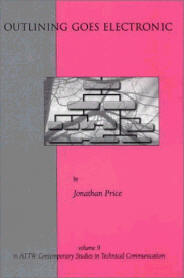Situating the outline in theory
Electronic outlining makes the old critique of outlines by the process
movement obsolete.
In the 1970's and 1980's, scholarship on the pedagogy
of arrangement tended to focus on the development of structure, rather
than on outlining as a set of useful activities. Scholars argued that a
concern for structure could take us beyond the patterns-of-development
approach and contribute to the process (Coe, 1987; Enos, 1985; Hartwell,
1979; Knoblauch & Brannon, 1984; Olsen, 1989; Podis, 1980, Podis & Podis,
1990).
Wary of offering an "outline" as a static arrangement promising
students control over material, Podis and Podis (1990) even stressed their
own anxiety, indecision, hemming and hawing, their own experience of being
out of control, as they arranged their essay on arrangement.
In investigating the way writers plan their work, Hayes & Flower (1980)
and Kaufer, Fleming, Werner, & Sinsheimer-Weeks. (1986) suggested that
after mentally mulling over the subject, a writer might write down a plan
in an outline form.
But Flower & Hayes (1980, 1981a, 1981b) criticized the
outline as a product-based plan, the kind of plan that occurs "when the
composing process is governed by a concern for the form of the finished
product" (1981b, p. 49), and suggested that the difficulty of producing a
formal outline could slow the writer down.
In 1984 they drew a distinction
between fragmentary, vague, and incomplete plans for writing, which they
saw as useful, and "more formal, logical, and limited 'plans,' associated
with outlines and notes" (1984, p. 124).
Stotsky (1990) pointed out that
in much research on planning, the ideas of goals, plans, and
strategies
were conflated or left astonishingly vague. She concluded: "It is not
clear what kind of plans the process of planning results in or how plans
and goals may be distinguished from one another, if indeed they are
distinct entities" (p. 42). She noted how practitioners applied theory and
found similar confusion.
Researchers on the composing process had also
found that writers contemplating a short piece rarely outline (Bereiter &
Scardamalia, 1987; Emig, 1971; Hillocks, 1986; Mischel, 1974; Perl, 1979;
Pianko, 1979; Stallard, 1974).
But writers facing a longer or more
complex document often do create an outline (Emig, 1971; Kellogg, 1988, 1994; Kulthau, 1988;
McCarthy, 1985; Nelson, 1992; Sommers & McQuade, 1984; Stein, 1990; Taylor
& Beach, 1984).
But, as Stotsky (1990) says, "The practice of formal outlining
recommended in traditional texts may be inhibiting" (p. 46).
Indeed, the traditional model
presented an outline as a single document, not as a process--a document
decorated with typographical codes borrowed from mathematics and Latin,
arranged in nested sequences that few students comprehend; a document,
moreover, that acts as a rigid blueprint the student must follow when
drafting, with any variations (or new ideas) being punished by the teacher
as a violation of contract.
In other words, the real purpose of
outlining--to develop a meaningful structure for the document--became lost
amid the use of
- Paper as the medium (which made changing anything difficult). In
fact, Daiute (1985) pinpointed the paper medium as a major obstacle to the
formal outlining recommended universally by teachers and textbooks from
the 1930's through the 1960's.
- Pens or typewriters as the tools (which afforded few ways of
indicating hierarchy other than indentation and the extremely arbitrary
typographical codes indicating levels and sequences)
- A pedagogy favoring forms over process, and
stressing individual work (one student, one outline) over group work.
Going beyond the traditional model
Influenced by cognitive psychologists' distinction between thinking and
writing (Newell & Simon, 1972; Schank & Abelson, 1977), writing
researchers have continued to consider an outline as a written-down
thought rather than viewing the process of outlining as a way of thinking.
Stotsky (1990) points out, "The interaction between thought and written
language during the planning process may be the critical activity that
determines the coherence of the first draft" (p. 49). She suggests a more
intimate relationship between composing and drafting than cognitivists
acknowledged, and, following Vygotsky, she stresses that as writers think
verbally, they move back and forth "between thought and visible (or
audible) language" (Stotsky, 1990, p. 54).
In my experience, outlining electronically allows individuals and groups
to think aloud, record their thoughts onscreen, analyze those thoughts as
if they came from an "other," and collectively come to a new
understanding.
Outlining software also blurs old distinctions between
planning, researching, and drafting.
Although not directly dealing with
outlines, most studies in the last 25 years have shown that the various
processes involved in writing occur again and again, recursively
overlapping, and frequently intersecting with each other (Beaugrande,
1984; Hult & Harris, 1987; Kellogg, 1994; Kennedy, 1985; Kostelnick,
1989a; McCutchen, 1986; Moberg, 1986; Schwartz, 1985).
What's odd is that
outlining gets mentioned so rarely in this discussion.
Kellogg (1994)
noted that "Research on outlining is limited" (p. 124). Reviewing
observational and field research on prewriting, he says,
"The only strong,
positive effect is the correlation between outlining and productivity. The
studies that yielded null or negative results all suffer from low
statistical power, using in most cases only a handful of participants" (p.
125).
To correct this gap in the research, Kellogg undertook a number of
surveys and experiments.
- In interviewing science and engineering faculty he found that
written outlining had a significant correlation with productivity
(Kellogg, 1986, 1994).
- In fact, in another study, Kellogg
(1988) showed that writers who had prepared an outline mentally or in
writing were able to reduce attentional overload, when drafting, so they
could concentrate substantially more on translating their ideas from the
plan to written form, as Murray (1985) had suggested.
Kellogg concluded
that for long documents an external outline (written, not mental) would be
critical, as Stotsky (1990) also argued.
Looking back over the same decades of research as Kellogg does, Walvoord
et al. (1995) say,
"In this body of research, outlining is either
absent, conflated with other categories, classified in such a way as to
obscure its unique features, specifically omitted from powerful writing
processes, or negatively associated with linear or unproductive composing
practices" (p. 393).
They point out that Flower & Hayes (1977) attacked
outlines as mere products, ignored their position as bridges between
planning and writing, dismissed outlines as encouraging writers to "paint
by numbers--to simply fill in the blanks" (p. 457), and condemned them as
crutches and a straitjackets.
Hillocks (1986) also dismissed such textbook
mantras as "formulate a thesis, develop an outline, and write" (p.
27). Walvoord et al. (1995) point out
"But now that the research so richly suggests the fluidity, complexity,
and interconnectedness of writing processes and forms, it is time to
unhitch the outline from its narrow textbook definition to explore how
students actually use it, and to reconsider it in that context" (p. 394).
In their study of college students' development of complex papers in
several disciplines, Walvoord et al. (1995) found that outlining appeared
to be: "A powerful strategy that cut across, participated in, and
transcended individual processes such as planning or organizing [and
served] multiple functions across a broad span of the writing process" (p.
418).
Certainly, in my own experience, electronic outlining, as a process,
evolves cyclically, almost randomly, affecting and strengthening all three
activities--researching, organizing, and writing.
Outlining is a sociable activity
Just as the move to word processing encouraged and made more visible the
social nature of writing (Costanzo, 1994; Duin & Hansen, 1994; Eldred,
1989; Hawisher, 1994; Humphrey, 1987; Rodrigues & Rodrigues, 1986),
electronic outlining encourages a social perspective.
Duin & Hansen (1994)
define the social perspective this way:
Social interaction can be seen as the mechanism for the process of social
construction, the means by which individuals cooperate to construct and
interpret reality, and a means by which individuals become literate....
The basic idea of social construction is that groups of people, bound by
shared experiences or interests, build meaning through an ongoing process
of communication, interpretation, and negotiation. Facts, beliefs, truth
itself result from a social process of conversation and consensus
building. (pp. 90-91)
Because of rhetorical concerns with audience, much discussion focuses on the conversation between the writer and the reader, as
suggested by Bakhtin (1981, 1986), Bakhtin & Volosinov (1986), and
Volosinov (1973).
But with the increase of group writing, more scholars
recognize that writing itself can be done collaboratively, as an extended
conversation (Duin & Hansen, 1994; Ede & Lunsford, 1990). Unfortunately,
few researchers have explored electronic outlining within this context.
Similarly, the electronic tools enabling groups to create hypertexts
together foster the social construction of knowledge and text (Adelson &
Jordan, 1992; Irish & Trigg, 1989), but, as Johnson-Eilola (1994) points
out, most hypertext theorists have either disregarded the interplay of
technology and social practice, or focused too exclusively on the
technology (see also Hawisher, 1989, Kaplan, 1991).
Johnson-Eilola (1994)
remarks, "The social aspects of the construction of knowledge are not
always visible to the participants" (p. 214).
I argue that electronic
outlining, used in the workplace and classroom, encourages social
interaction as a group works out "what it knows," and makes that process
visible.
In the context of the extensive scholarship on writing, then, outlining as
an activity remains weakly theorized, and despite increased interest in
word processing and hypertext, outlining on the computer has not been
seriously explored for its full capabilities. Farkas (1995) called for
more study of electronic outlining because he saw it as a valuable tool.
In my book, Outlining Goes Electronic, I provide some indication of the way electronic outlining
works in industry and in the classroom as a device for thinking, as a
facilitator of collaboration, and as an eye-opening representation of the
social construction that goes on during collaborative writing.
Citations from A bibliography of outlining.


